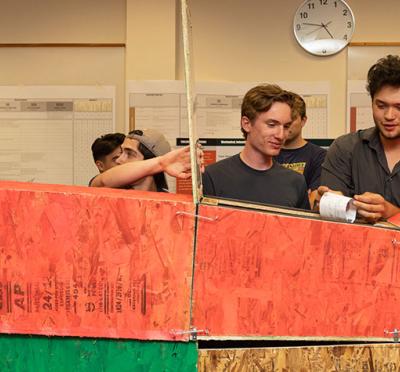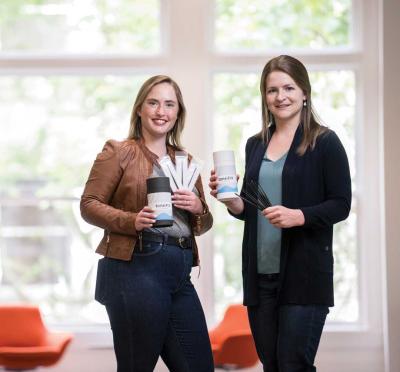
In 2015, Alex Hagmüller (’09 B.S. Mechanical Engineering) co-founded Aquaharmonics, a wave energy converter company, with Max Ginsburg (’10 B.S. Electrical Computer Engineering). After winning a $1.5 million Wave Energy Prize, they were awarded up to $5 million in U.S. Department of Energy funding to enhance and test their energy-converter concept in the ocean.
Where did your interest in wave energy come from?
Growing up in the small fishing town of Cordova, Alaska, I spent my summers working aboard commercial fishing boats. You get to experience firsthand how quickly things can change, from flat calm to absolute terror. There is nothing forgiving about the immense power of the ocean. While at OSU, I took a class with Dr. Annette von Jouanne, who was working on a wave energy converter that used a linear permanent magnet generator. She took us on a tour of her lab and was really excited to show the work being done on their linear test bed. I think these experiences formed the basis for my interest.
How did the School of MIME prepare you?
Formula SAE taught me invaluable skills in team-building, manufacturing, and practical design. Dr. Robert Paasch was a fantastic advisor and really allowed us to explore our interests, while still stressing the importance of function.
In addition, I attribute a lot of learning the rigors of numerical analysis to Dr. Nancy Squires. I did not find her class to be easy, but I did find it extremely fascinating. I was learning mathematics from a talented engineer who had seen it all. Dr. Squires was always available, always cheerful, never assuming, and humbling beyond words. It did not matter to her where your level of understanding was, she would efficiently give you the path to build your understanding.
In fact, just a few weeks ago we were developing a new numerical model in Matlab for our Wave Energy Converter. The problem needed to be transferred from time domain equations to frequency domain. After a bit of digging, I found the Fourier Transform notes that Dr. Squires had put together. There were the best and cleanest explanations and derivations I had ever come across, and completely relevant to the task at hand! (Thanks again, Dr. Squires!)
What is your best memory from your time at OSU?
Participating on the Formula SAE team, you are confronted with the incredible amount of work and skill required to build a successful race car, which can take its toll on a student. Balancing the team project, work and school was challenging, and often it felt like you are doing all these things but none of them very well. That is a difficult thing to work through, and you really have to refine what success means for you, and what your priorities are. You eventually come to the conclusion that you can only do so much; you only have so much time, so much focus. It causes you to organize in a different way from everyone else and be responsible for what you are delivering in a different way. That being said, there is nothing easy about this process, and it can result in a lot of stress and despair at times. In these darkest of moments is when the silliness reigns supreme; you remember the power of goofing off and how productive and emancipating that can be. One spends so much time and effort on these very rigorous, disciplined subjects, and everything becomes so serious. It’s in these moments you really find that connection with your team, and this can result in much ridiculousness.
Want to learn more about AquaHarmonics? Listen to this recent episode of Engineering Out Loud, the podcast from the College fo Engineering at Oregon State.



